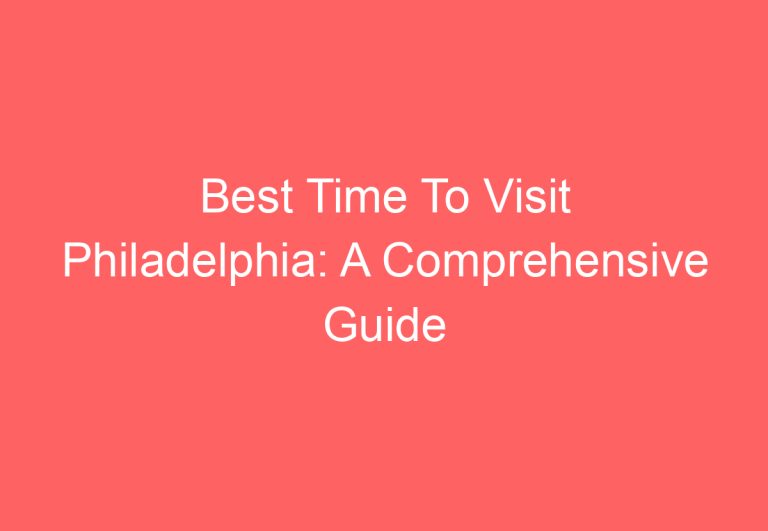Best Time To Visit Washington Dc: A Comprehensive Guide
Washington D.C. is a city that is steeped in history and culture. It is home to some of the most iconic landmarks and attractions in the United States, including the White House, the Lincoln Memorial, and the Smithsonian museums. If you are planning a trip to Washington D.C., you might be wondering when the best time to visit is.

The answer to this question depends on a variety of factors, including your personal preferences, your budget, and the weather. Generally speaking, the best times to visit Washington D.C. are in the spring and fall. During these seasons, the weather is mild and pleasant, and there are plenty of events and festivals to enjoy. However, if you want to see the famous cherry blossoms, you will need to visit in late March or early April.
It is also worth noting that Washington D.C. can get quite crowded during peak tourist season, which is typically from June to August. If you want to avoid the crowds and save money on accommodations, consider visiting in the winter months. While it may be chilly, there are still plenty of indoor attractions to enjoy, such as the museums and art galleries. Ultimately, the best time to visit Washington D.C. will depend on your individual preferences and priorities.
Optimal Seasons for Visiting Washington DC

Washington DC is a popular destination for tourists from all around the world. The city has a lot to offer, from its iconic landmarks to its rich history and culture. However, the best time to visit Washington DC depends on what you want to do and see. In this section, we’ll explore the optimal seasons for visiting Washington DC.
Spring: Cherry Blossoms and Mild Weather
Spring is one of the best times to visit Washington DC, especially if you want to see the famous cherry blossoms. The National Cherry Blossom Festival takes place in early April, and it’s a great time to visit the city. The weather is mild, and the crowds are not as overwhelming as they are during the peak season. The average temperatures during spring are around 60°F to 70°F, which is pleasant and comfortable.
Fall: Colorful Foliage and Comfortable Climate
Fall is another great time to visit Washington DC. The changing leaves create a beautiful backdrop for the city’s landmarks, and the climate is comfortable. The temperatures during fall are around 50°F to 70°F, which is ideal for outdoor activities. September to November is the best time to visit Washington DC during the fall season.
Winter and Summer: Considerations and Events
Winter and summer are not the optimal seasons for visiting Washington DC, but they have their own unique events and considerations. Winter can be cold and snowy, which can make it difficult to explore the city. However, there are some great indoor activities and events, such as the National Christmas Tree Lighting and the Smithsonian museums. The summer can be hot and humid, which can also make it uncomfortable to explore the city. However, there are some great outdoor events, such as the Fourth of July fireworks and the Smithsonian Folklife Festival.
In conclusion, the best time to visit Washington DC depends on what you want to do and see. Spring and fall are the optimal seasons for visiting the city, but winter and summer have their own unique events and considerations. By planning your trip accordingly, you can make the most out of your visit to Washington DC.
Cultural Events and Activities

Washington DC is a city rich in history and culture, with a diverse range of events and attractions throughout the year. From festivals and museums to historical landmarks and tours, there is something for everyone in the nation’s capital.
Festivals and National Events
One of the most popular festivals in Washington DC is the National Cherry Blossom Festival, which takes place in March and April. Visitors from around the world come to see the beautiful cherry blossom trees in bloom and participate in a variety of cultural events and activities. Another popular event is the Smithsonian Folklife Festival, which celebrates the cultural traditions of different regions and communities from around the world. Other notable festivals include the H Street Festival, Downtown Holiday Market, Citi Open, Capital Pride, and Fourth of July fireworks.
Museums and Historical Attractions
Washington DC is home to some of the most famous museums and historical landmarks in the world. The Smithsonian Institution, which includes 19 museums and galleries, is a must-visit for any tourist. The National Mall is also home to many iconic landmarks, including the Washington Monument, Lincoln Memorial, and the U.S. Capitol Building. Other popular attractions include the Library of Congress, White House, and Tidal Basin.
Planning Your Visit: Timing and Budget
When planning a trip to Washington DC, it’s important to consider the timing and budget. The best times to visit are from September to November and March to May, as the weather is mild and the crowds are smaller. However, these are also the peak tourist seasons, so hotel deals may be harder to find. The summer months can be hot and humid, but there are many free outdoor concerts and events. The winter months are the cheapest time to visit, but some attractions may be closed or have limited hours.
Visitors should also consider the cost of attractions and tours, as some can be quite expensive. However, there are many free museums and attractions in Washington DC, including all of the Smithsonian museums and the National Zoo. School groups may be eligible for discounts, and there are many budget-friendly neighborhoods and hotels outside of the city center.
Overall, Washington DC is a city full of culture and history, with something for every type of visitor. Whether you’re interested in festivals, museums, or historical landmarks, there’s no shortage of things to see and do in the nation’s capital.
Frequently Asked Questions

What months offer the most comfortable weather for touring the capital?
Washington DC experiences four distinct seasons, with summer temperatures often reaching the high 80s and winter temperatures dropping below freezing. For comfortable weather, the best time to visit is from March to May or September to November. During these months, temperatures are mild, and the city is less crowded.
How can one experience the Cherry Blossom Festival optimally?
The National Cherry Blossom Festival takes place annually from late March to early April. To experience the festival optimally, plan to visit during the second or third week of April when the trees are in full bloom. The festival offers various events, including parades, fireworks, and cultural performances.
Which season is most recommended for budget-conscious travelers?
If you’re looking to save money, consider visiting during the winter months from December to February. During this time, hotel rates and airfare are often lower, and there are fewer crowds. However, keep in mind that the weather can be cold and snowy.
What days of the week are ideal for avoiding crowds in DC?
Weekdays are generally less crowded than weekends in Washington DC. If possible, plan your visit for Tuesday, Wednesday, or Thursday to avoid large crowds at popular attractions.
Can you recommend a time frame for a comprehensive visit to the city’s attractions?
To see all of the city’s main attractions, plan to spend at least three to four days in Washington DC. This will give you enough time to visit the National Mall, Smithsonian museums, and other popular sites.
What neighborhoods are preferred for tourists seeking convenient access to sites?
Tourists seeking convenient access to sites should consider staying in neighborhoods such as Dupont Circle, Georgetown, or Capitol Hill. These areas offer easy access to public transportation, restaurants, and shopping, making them ideal for visitors.






